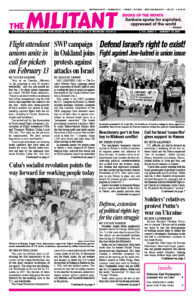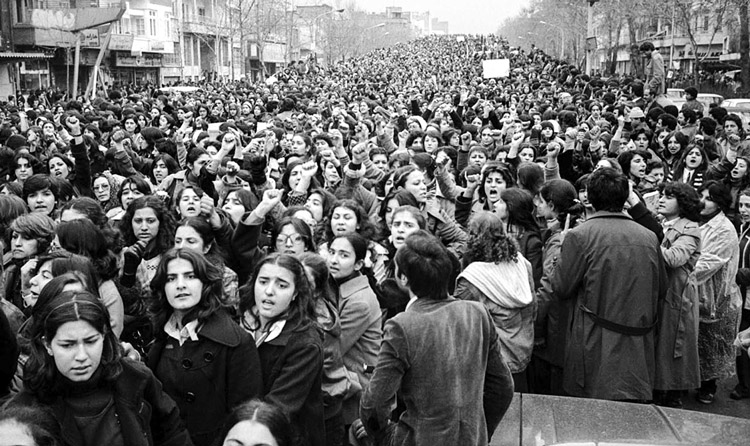The reactionary bourgeois clerical regime in Tehran is driven to increase its regional power and influence by force of arms. Its leaders strive to extend beyond Iran’s borders the four-decade-long political counterrevolution that pushed back the workers, farmers, women and oppressed nationalities that carried out the historic Iranian Revolution of 1979. Their latest move was to join Hamas to plan, arm and launch the Islamist group’s murderous pogrom in Israel Oct. 7.
Israel’s war today to dismantle Hamas is also a war to deal blows to the rulers in Tehran, who openly proclaim their program of Jew-hatred and call for the destruction of Israel.
Tehran claims it is leading an “axis of resistance” against Israel. Along with Hamas, its partners include Hezbollah in Lebanon, militia forces it fostered and leads in Iraq and Syria, as well as the Houthi rebel fighters in Yemen. They all share the Iranian rulers’ hatred of the Jews.
On Jan. 3 Iran’s Tasnim News Agency blamed Israel for Islamic State suicide bombers who killed 89 people attending a commemoration in Kerman, Iran, marking the assassination of Iranian Gen. Qassem Soleimani in 2018. “The Zionist regime ordered the ISIS caliphate” to carry out the attack, Tasnim claimed. This groundless charge is twisted to fit with the regime’s insistence Israel and the Jews need to be obliterated.
At the funeral for those killed, Iranian President Ebrahim Raisi hailed Hamas’ Oct. 7 slaughter, saying the pogrom marks the beginning of “the end of the Zionist regime.” Days later, Iranian Defense Minister Mohammed-Reza Ashtianti claimed that Israel “does not exist” and its people must “leave the region.”
Since Oct. 7 Tehran-backed Hezbollah has launched rocket attacks into northern Israel almost daily. Tehran’s forces provide intelligence, drones and missiles to Houthis in Yemen, who have launched attacks on the southern Israeli port of Eilat as well as cargo vessels sailing toward the Suez Canal. Iranian-provisioned militias in Iraq and Syria have attacked U.S. forces stationed there.
Beginning in late 2017 the devastating consequences of Tehran’s military adventures in the region have spurred waves of protests by Iranian working people. They’ve taken to the streets to demand an end to military interventions abroad and for turning the nation’s resources to address the needs of working people, including affordable prices for basic necessities, as well as rights for women and oppressed nationalities.
The most important curb against the threat of more military interventions by Tehran and its proxies is the working people of Iran and their struggles. Iranian government efforts to mobilize popular support for Hamas have largely fallen flat.
Washington and other capitalist governments refer to today’s regime in Tehran as the product of the 1979 Iranian Revolution. But the truth is that regime is the product of a brutal counterrevolution that fought to prevent working people from advancing the revolutionary struggle that brought down the tyrannical regime of the U.S.-backed shah.
A modern, popular revolution
The Iranian Revolution was a deep-going, modern, popular social revolution in city and countryside. It inspired working people across the Middle East and worldwide. Workers established shoras (councils) in factories, mills, refineries and other workplaces to press forward their own class interests. Women and oppressed nationalities fought for their rights, peasants for land.
The clerical forces that sat atop the Islamic Republic responded by fighting to put down these struggles, to prevent any inroads into capitalist rule. They attacked protests, arresting and executing political opponents and unleashing thug terror against those seeking to extend the revolution.
Iran’s Islamic Revolutionary Guard Corps was tasked with leading these assaults. It has become instrumental to the rulers’ military interventions that target both Israel and rival regimes in the Middle East. “We will export our experiences to the whole world,” Iran Supreme Leader Ayatollah Ruhollah Khomeini threatened in 1987. He called Israel a “cancerous Zionist tumor in the body of Islamic countries” and saluted all who “deal blows” to it.
Across the region the bourgeois clerical regime in Iran became a force of reaction.
The record of the rise and fall of the Iranian Revolution can be found in a 2018 special feature, “Revolution, counterrevolution and war in Iran” by Socialist Workers Party leader Steve Clark, available from the Militant.
The Hezbollah militia in Lebanon was founded in 1983 with direct involvement and funding from Tehran. Since then it has brokered its way into several Lebanese coalition governments, gaining access to funds and other resources. Hezbollah provoked a monthlong war against Israel in 2006. In 2019 Hezbollah thugs carried out assaults on protesters in Beirut fighting for better living conditions and against government corruption.
The Iraqi government also relies on militias organized by Iran’s Islamic Revolutionary Guards. During protests for jobs and political rights in Baghdad in 2019, demonstrators chanted “Iran get out, get out!” Deadly force was used to crush the actions, with Tehran-backed militias at the forefront. More than 500 people were killed.
Syrian ruler Bashar al-Assad unleashed massive repression in a failed attempt to quell a popular uprising in 2011. Tehran-backed militias and Moscow’s airstrikes were decisive in allowing Assad’s regime to reverse losses it suffered in the civil war that followed. More than 300,000 were killed and 6.8 million fled the country.
Fight to end Jew-hatred
Months before Hamas’ Oct. 7 bloodbath, the governments of Israel and Saudi Arabia were holding talks to pave the way for the Saudi rulers’ recognition of Israel, an expansion of the Abraham Accords. Tehran green-lighted the Hamas pogrom — the largest massacre of Jews since the Holocaust — when it did because it wanted to scuttle these plans, which for now are on hold.
But even an Israeli victory crushing Hamas — which will deal serious blows to Tehran as well — will not end Jew-hatred or future threats to Israel’s right to exist as a refuge for Jews. Their roots lie in the deepening crisis of capitalism, which leads to the ruin of growing layers of the middle class, many of whom blame the Jews for the disaster they face. Jew-hatred becomes the banner of reactionary forces the capitalist rulers turn to when they fear their rule is threatened.
This is what led to the Hitler regime in Germany. And the Nazi Holocaust — coupled with the decision of the rulers in Washington, London and other capitalist governments to shut their borders to Jews before, during and after the second imperialist world war — is what led to the creation of Israel.
In the course of revolutionary struggles to come, workers will have the opportunity to overturn capitalist rule and take power and our destiny into our own hands. This will open the door to finally wipe out Jew-hatred, along with all other poisonous products of capitalist exploitation and oppression — in the U.S., the Middle East and worldwide.


